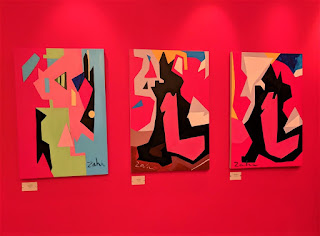“I advise students on the subject of color as follows: If it
looks good enough to eat, use it,” said artist Abe Ajay. Strawberries, summer
tomatoes, red peppers. Yum. Yes, I know “seeing red” can mean
uncontrollable anger, but more often, red has been associated with love,
courage, revolution. Scientists have
found that of all colors, red evokes the strongest reaction; thus, warnings,
stop signs, the “scarlet letter,” ecclesiastical robes, flags, even wedding
garments in other cultures. Red is one of the first colors used by artists—red
ochre was used as body paint in the late Stone Age, and Paleolithic cave
paintings were done in red, the color easily obtained in nature. Fun fact:
traces of red ochre were found on a painter’s palette in King Tut’s
tomb! Chinese created vermilion,
brought to Europe by Arabs, became popular with Renaissance artists like
Titian. The pigment, known as Chinese
red, was as expensive as gold leaf. It
remained the most popular red through the 20th century, but its toxicity and expense
encouraged artists to switch to cadmium red.
Nature, hand in hand with artists, evolved many hues—cinnabar, crimson,
carmine (from the cochineal insect, Spanish conquistadors taking it from the
Aztecs. Ultimately it was most
associated with Rembrandt and Vermeer.
Colonialism and appropriation from the earliest days.
As a curator, I am sensitive to color, as the red wall in my
gallery (even mentioned in The Washington Post) attests. In my personal life, I
go with black most of the time, but when asked, I always say my favorite color
is red. I’ve often wondered why most people seem to have a “favorite.” An
article by R. Douglas Fields Ph.D. in Psychology Today suggests “Color
preferences are deeply rooted emotional responses that seem to lack any
rational basis.” “But is ...color preference hard-wired by evolution or
learned? Interestingly, the researchers found that Japanese color preferences
were different from American preferences, suggesting a cultural influence on
color preference.” Choice of color can be seen as an aggressive act, wearing
all black is sometimes interpreted as sinister, the choice of a rebel (black
motorcycle jackets being an emblem of “rebel cool” in American culture). Others
see it as simply chic (the famous “black uniform” of New York women). It can
also be practical, as is mentioned in a book, “Life Among the Poor in Cairo.” Women
of all classes living in the same Cairo neighborhood chose to wear black garments (sometimes covering a more
colorful one underneath). This made it possible to “level the playing field” of
fashion, as cheaper materials can be perceived to be similar to expensive
fabrics, at least from a distance. Me, I see both black and red as neutrals,
providing background to the statement I wish to make, both in my personal
choices and as a curator. I’ve had the red wall for many years now. Originally,
I painted it to showcase a particular set of paintings about the Arab Spring.
Since then, every painting I have installed there looks as if it were made for
the wall. (Admission: I’ve unearthed my old school textbooks on color theory
just to be sure.) But in many ways, the background becomes the foreground, in
art and in life. We all make choices in
how to present ourselves to the world, whether in clothing or in art. Color
provides non-verbal cues to our emotions, or sense of self, and the messages we
wish to impart. So, if black is your
happy place, good for you. And if you choose to splatter rainbow hues like
Jackson Pollack, hurrah. The philosopher Marshal McLuhan (anyone remember him?)
famously said, “The medium is the message.” Art Heals.
This is Zahi Khamis’s Forbidden on the red wall.

No comments:
Post a Comment